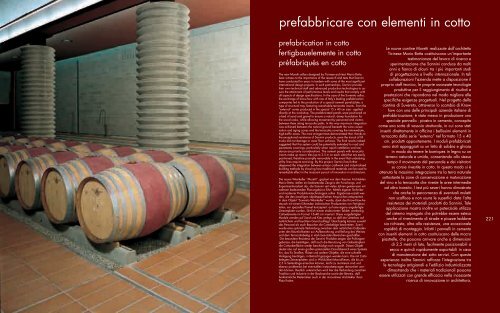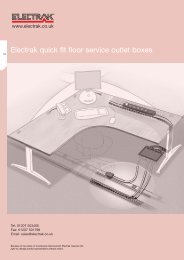by Stone & Sannini - EKA Group
by Stone & Sannini - EKA Group
by Stone & Sannini - EKA Group
Create successful ePaper yourself
Turn your PDF publications into a flip-book with our unique Google optimized e-Paper software.
prefabbricare con elementi in cotto<br />
prefabrication in cotto<br />
fertigbauelemente in cotto<br />
préfabriqués en cotto<br />
The new Moretti cellars designed <strong>by</strong> Ticinese architect Mario Botta<br />
bear witness to the importance of the research and tests that <strong>Sannini</strong><br />
have conducted for years in tandem with some of the most significant<br />
international design projects. In such partnerships, <strong>Sannini</strong> provide<br />
their own technical staff and advanced production technologies to assure<br />
the attainment of performance levels and results that comply with<br />
all aspects of design specifications. In the case of the Suvereto cellar,<br />
the exchange of know-how with one of Italy’s leading prefabrication<br />
companies led to the production of a special cement panel/plate, a<br />
type of structural tray, featuring remarkable terracotta inserts - from the<br />
“external” series produced in the special 15 x 40 cm size - applied<br />
directly at the workshop. The prefabricated panels were positioned on<br />
a bed of sand and gravel to ensure a natural, damp foundation for<br />
the wood casks, while allowing movement <strong>by</strong> personnel and visitors<br />
between them along terracotta paths. In this way maximum integration<br />
was achieved between the natural ground beneath the wine conservation<br />
and aging zones and the terracotta covering the intermediate,<br />
high-traffic areas. The most stringent tests demonstrated that, thanks to<br />
the exceptional resistance of <strong>Sannini</strong> products, even the transit of lift<br />
trucks did not damage or wear floor surfaces. The final results indeed<br />
suggested that this system could be potentially extended to road and<br />
pavements coverings, particularly when rapid installation and resistance<br />
are priority considerations. The cement panels with terracotta<br />
inserts make up macro tiles (up to 2.5 m on each side) that are easily<br />
positioned, therefore promptly removable in the event that underlying<br />
utility lines require servicing. By this project, <strong>Sannini</strong> has further<br />
deepened the integration between artisan craftwork and industrialised<br />
building methods <strong>by</strong> showing how traditional materials can be used to<br />
remarkable effect in the incessant pursuit of innovation in architecture.<br />
Die neuen Weinkeller “Moretti”, geplant von dem Tessiner Architekten<br />
Mario Botta, stellen ein bedeutendes Zeugnis der Forschungs- und<br />
Experimentierarbeit dar, die <strong>Sannini</strong> seit vielen Jahren gemeinsam mit<br />
weltweit bedeutenden Planungsbüros führt. Mittels eigener Techniker<br />
und moderner Produktionstechnologien sollen Ergebnisse erzielt werden,<br />
die den jeweiligen objektspezifischen Ansprüchen entsprechen.<br />
In dem Objekt “Suvereto Weinkeller” wurde, dank des Know-How-Austausch<br />
mit einem führenden italienischen Produzenten von Fertigbauteilen,<br />
ein spezielles Paneel konzepiert: auf eine eigens angefertigte<br />
Zementplatte wurden, ähnlich einem strukturierten Tablett, werkseitig<br />
Cottoelemente im Format 15x40 cm inseriert. Diese vorgefertigten<br />
Module werden auf Sand und Kies verlegt, so daß der Unterbau auf<br />
natürlichem und feuchtem Grund aufliegt. Gleichzeitig können sowohl<br />
das Personal als auch Besucher die Cottobeläge beschreiten. Somit<br />
wurde eine optimale Verbindung zwischen dem natürlichen Erdboden<br />
unter den Räumlichkeiten zur Aufbewahrung und Reifung des Weines<br />
und dem Terracottabelag in stark benutzten Bereichen geschaffen.<br />
Die besondere Resistenz der <strong>Sannini</strong> Produkte zeigen die Prüfungsergebnisse,<br />
die bestätigen, daß auch die Benutzung von Gabelstaplern<br />
die Cottooberfläche weder beschädigt noch angreift. Dieses Objekt<br />
deutet also auf einen großen potenziellen Einsatzbereich eines Systems<br />
hin, das für Straßen, Plätze und andere Objekte, die eine schnelle<br />
Verlegung benötigen, in Betracht gezogen werden kann. Die mit Cotto<br />
belegten Zementplatten sind in Wirklichkeit Macrofliesen, die bis zu<br />
2,5 m Seitenlänge erreichen können, leicht zu montieren sind und<br />
ebenso problemlos bei eventuellen Instandsetzungen abmontiert werden<br />
können. Deutlich unterstrichen wird hier die Verbindung zwischen<br />
Tradition und Industrie in der Baubranche sowie der Beweis, daß<br />
herkömmliche Materialien auch in der innovativen Architektur ihren<br />
Platz finden.<br />
Le nuove cantine Moretti realizzate dall’architetto<br />
Ticinese Mario Botta costituiscono un’importante<br />
testimonianza del lavoro di ricerca e<br />
sperimentazione che <strong>Sannini</strong> conduce da molti<br />
anni a fianco di alcuni tra i più importanti studi<br />
di progettazione a livello internazionale. In tali<br />
collaborazioni l’azienda mette a disposizione il<br />
proprio staff tecnico, le proprie avanzate tecnologie<br />
produttive per il raggiungimento di risultati e<br />
prestazioni che rispondano nel modo migliore alle<br />
specifiche esigenze progettuali. Nel progetto della<br />
cantina di Suvereto, attraverso lo scambio di Know<br />
how con una delle principali aziende italiane di<br />
prefabbricazione, è stato messo in produzione uno<br />
speciale pannello - piastra in cemento, concepito<br />
come una sorta di vassoio strutturale, in cui sono stati<br />
inseriti direttamente in officina i bellissimi elementi in<br />
terracotta della serie “externa” nel formato 15 x 40<br />
cm. prodotti appositamente. I moduli prefabbricati<br />
sono stati appoggiati su un letto di sabbia e ghiaia<br />
in modo da tenere le barriques in legno su un<br />
terreno naturale e umido, consentendo allo stesso<br />
tempo il movimento del personale e dei visitatori<br />
su corsie rivestite in cotto. In questo modo si è<br />
ottenuta la massima integrazione tra la terra naturale<br />
sottostante le zone di conservazione e maturazione<br />
del vino e la terracotta che riveste le aree intermedie<br />
ad altro transito. I test più severi hanno dimostrato<br />
che anche la percorrenza di eventuali muletti<br />
non scalfisce e non usura le superfici data l’alta<br />
resistenza dei materiali prodotti da <strong>Sannini</strong>. Tale<br />
applicazione mostra inoltre un potenziale utilizzo<br />
del sistema impiegato che potrebbe essere esteso<br />
anche al rivestimento di strade e piazze laddove<br />
sia richiesta, oltre alla resistenza, una eccezionale<br />
rapidità di montaggio. Infatti i pannelli in cemento<br />
con inseriti elementi in cotto costituiscono delle macro<br />
piastrelle, che possono arrivare anche a dimensioni<br />
di 2,5 metri di lato, facilmente posizionabili a<br />
secco e quindi rapidamente asportabili in caso<br />
di manutenzione dei sotto servizi. Con questa<br />
esperienza inoltre <strong>Sannini</strong> rafforza l’integrazione tra<br />
le tecnologie artigianali e l’edilizia industrializzata<br />
dimostrando che i materiali tradizionali possono<br />
essere utilizzati con grande efficacia nella incessante<br />
ricerca di innovazione in architettura.<br />
221





